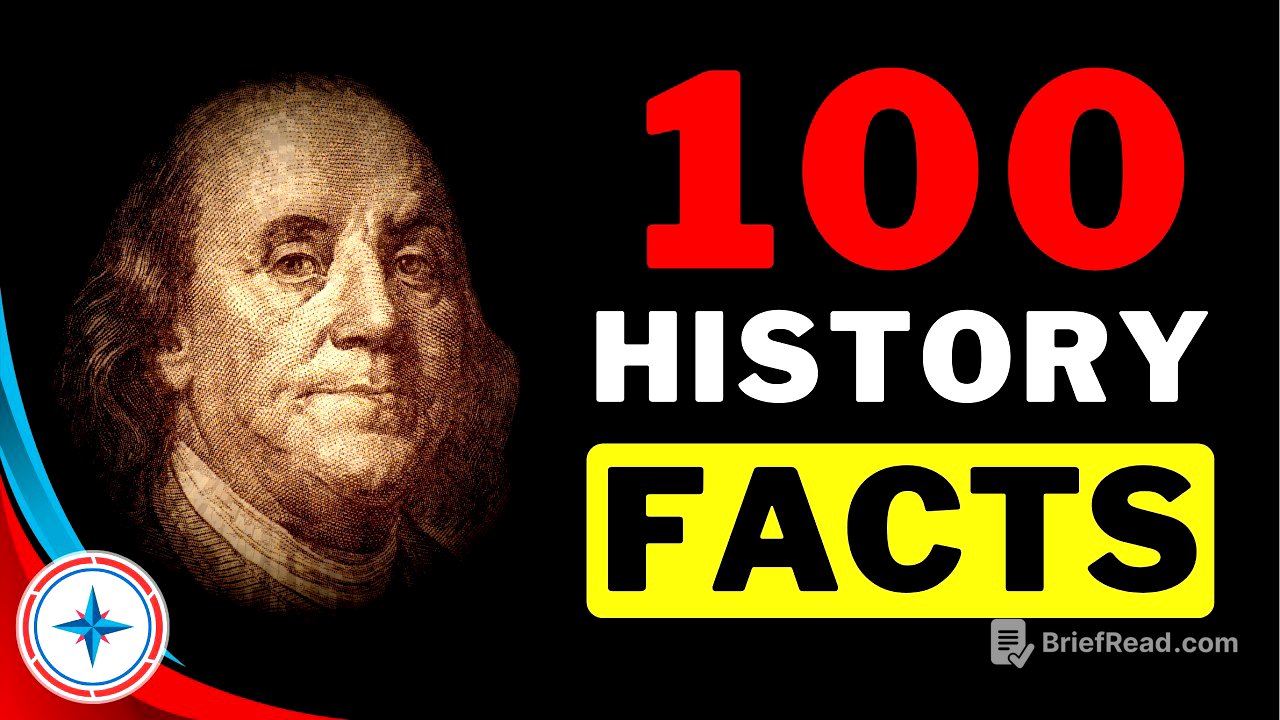TLDR;
This video presents a collection of intriguing and often bizarre historical facts, spanning various cultures and time periods. It covers topics ranging from ancient hygiene practices and medical oddities to surprising details about famous figures and pivotal events.
- Benjamin Franklin's unusual health habits.
- The democratic nature of pirate ships.
- The accidental creation of the metric system and Hollywood.
- The surprising origins of canned food and the modern calendar.
- The unexpected use of rice glue in the Great Wall of China.
Benjamin Franklin's Air Baths and the First Computer Bug [0:03]
Benjamin Franklin believed in the health benefits of cold air and practiced daily nude air baths. In 1947, engineers found a moth stuck in a relay of Harvard's Mark 2 computer, which they documented as the "first actual case of bug being found," giving a literal origin to the term "computer bug."
Ketchup as Medicine, Ancient Toothpaste, and the Dancing Plague [1:15]
In the 1830s, ketchup was marketed as a medicine by Dr. John Cook Bennett, who claimed it could cure diarrhea and indigestion. Ancient Egyptians used surprisingly effective toothpaste made from crushed eggshells, powdered ox hooves, and ash. In 1518, a dancing plague struck Strasbourg, where hundreds danced uncontrollably for months, with no known cause.
Pirate Democracy, Dracula's Heroism, and Ancient Pregnancy Tests [2:33]
Contrary to popular belief, pirates operated democratically, electing their captains and sharing loot equally. Vlad the Impaler, the inspiration for Dracula, is considered a national hero in Romania for his ruthless efficiency and resistance against the Ottomans. Ancient Egyptians used a pregnancy test involving urinating on wheat and barley seeds, which had an 85% accuracy rate.
The First Online Sale and a Journalist's Adventures [3:51]
In 1971, Stanford students used Arpanet to arrange a cannabis deal with MIT students, marking the first online sale. Journalist Nelly Bly went undercover in a mental asylum to expose horrific conditions and then raced around the world in 72 days, surpassing the fictional record of Phileas Fogg.
Cleopatra's Timeline, the Cat Purge, and Female Gladiators [4:36]
Cleopatra lived closer to the moon landing than to the construction of the pyramids, highlighting how ancient Egypt was already ancient to her. In 1233, Pope Gregory IX linked cats to Satan, leading to a cat extermination that inadvertently contributed to the spread of the Black Death. Ancient Rome had female gladiators, known as gladiatrices, who fought in arenas.
The Pirate Queen, Olympic Art Medals, and Base Number Systems [5:48]
Ching Shih, a pirate queen, commanded over 70,000 pirates and 1,200 ships in the South China Sea, retiring rich and undefeated. From 1912 to 1948, the Olympics awarded medals for art inspired by sports. The Babylonians used a base 60 number system, which is why we have 60 seconds in a minute and 60 minutes in an hour.
Lincoln's Wrestling Career, a Parrot's Profanity, and the Emu War [7:06]
Abraham Lincoln was a wrestling legend, with a record of over 300 matches and only one loss, and was inducted into the National Wrestling Hall of Fame in 1992. President Andrew Jackson's parrot, Paul, was removed from his funeral for swearing loudly. In 1932, the Australian army lost a battle against crop-destroying emus.
Oxford's Age, Alexander the Great's Possible Premature Burial, and St. Lawrence's Wit [8:48]
Oxford University is older than the Aztec Empire, with teaching starting in 1096. Alexander the Great may have been buried alive due to Guillain-Barré syndrome, which paralyzed him but didn't kill him. St. Lawrence, when grilled over a fire, quipped, "Turn me over. I'm done on this side," becoming the patron saint of chefs and comedians.
Arctic Camels, Lord Byron's Bear, and a Baboon Railway Worker [10:04]
Millions of years ago, Arctic camels roamed North America. Lord Byron brought a bear to Trinity College because dogs were not allowed. James Wide, a railway worker who lost his legs, trained a baboon named Jack to operate signal levers, and Jack was officially hired for his competence.
Missing History, Forks as the Devil's Tool, and a Friendly Interrogator [11:18]
97% of human history is missing because written records only cover the last 6,000 years of the 200,000 years humans have existed. In medieval Europe, using a fork was considered blasphemous. Hans Scharff, a German interrogator during World War II, used friendly tactics instead of torture to gain prisoners' trust.
Mary's Little Lamb, the Metric System's Origins, and a Pope's Romance Novel [12:32]
The nursery rhyme "Mary Had a Little Lamb" originated from a true story about Mary Sawyer bringing her pet lamb to school. The French Revolution sparked the creation of the metric system to standardize measurements. Before becoming Pope Pius II, Aeneas Piccolomini wrote a steamy romance novel that became a bestseller.
Edison's Accidental Hollywood and Napoleon's Canned Food [13:54]
Thomas Edison's patent lawsuits drove filmmakers to flee New Jersey and establish Hollywood in Los Angeles. Napoleon Bonaparte's need for better food preservation led to the invention of canned food by Nicholas Appert.
Caesar's Calendar, the Shortest War, and Caligula's Horse [15:06]
Julius Caesar invented the modern calendar with 365-day years and leap years. The world's shortest war lasted 38 minutes between Britain and Zanzibar in 1896. Roman Emperor Caligula loved his racehorse Incitatus so much that he allegedly planned to make him a consul.
Castro's Survival, London's Fire Insurance, and Religion Before Farming [16:51]
Fidel Castro survived over 634 assassination attempts. The Great Fire of London in 1666 led to the creation of modern fire insurance. The construction of Göbekli Tepe predates farming, suggesting that religion may be older than agriculture.
Hemingway's Plane Crashes, a Corpse on Trial, and a Tiger's Reign of Terror [18:15]
Ernest Hemingway survived two plane crashes in 24 hours in 1954. Pope Stephen VI exhumed his predecessor, Pope Formosus, and put the corpse on trial in 897 AD. The Champawat Tiger killed 436 people before being stopped by Jim Corbett in 1907.
A Living Grandson from the 1700s, Early Fax Machines, and the Oldest Complaint Letter [19:38]
A U.S. president has a living grandson from the 1700s due to late-in-life children in subsequent generations. The first fax machine dates back to 1843. The world's oldest complaint letter, dating back to 1750 BC, was written by a man named Nani to a merchant about low-quality copper.
Sleep Deprivation and Catastrophes, a Rabbit Hunt Gone Wrong, and the First Museum Curator [21:10]
Sleep deprivation has been linked to catastrophes like Chernobyl and the Exxon Valdez oil spill. Napoleon planned a rabbit hunt that backfired when the rabbits charged at him. In 530 BC, Princess Ennigaldi-Nanna of Babylon ran a museum with labeled artifacts.
Erasing Genghis Khan, Ancient Perfume Cones, and Roman Public Toilets [22:30]
During Soviet times, Genghis Khan's name was erased from textbooks in Mongolia. Ancient Egyptians used solid perfume cones that melted throughout the day. Roman public toilets were social hubs where people chatted while using communal sponges.
Medieval Animal Trials, Viking Hygiene, and Rice Glue in the Great Wall [23:45]
In medieval Europe, animals were put on trial for crimes. Vikings were surprisingly hygienic, using tweezers, combs, and hot springs. The Great Wall of China was built using rice glue, making it incredibly durable.
Mummy Unwrapping Parties, Einstein's Stolen Brain, and Tug-of-War in the Olympics [25:04]
In the 1800s, rich Victorians held mummy unwrapping parties. After Einstein died, his brain was stolen and sliced into pieces for research. Tug-of-war was an Olympic sport from 1900 to 1920.
Lady Liberty as a Lighthouse, the Eiffel Tower's Temporary Status, and Gladiator Celebrities [26:29]
The Statue of Liberty served as a working lighthouse for 16 years. The Eiffel Tower was originally meant to be temporary and was almost torn down. Some gladiators were free men who became celebrities and earned serious money.
Naked Greek Athletes, a Dog Accused of Witchcraft, and the Ghost Army [27:51]
Ancient Greek athletes competed naked as a tribute to the gods. During the Salem witch trials, a dog was accused of witchcraft and executed. The US Ghost Army used inflatable tanks and fake radio chatter to deceive the Nazis during World War II.
Mummified Animals, Medieval Leeches, and Viking Skiing [29:30]
Ancient Egyptians mummified animals as offerings to the gods. Medieval doctors used leeches for treating illnesses. Vikings loved to ski for transportation and recreation.
Ancient Roman Roads, Greek Theater Masks, and Blackbeard's Mystery [30:35]
Ancient Roman roads were so well-built that many are still in use today. Ancient Greek theater used oversized masks to amplify emotions and project voices. Blackbeard's real name remains a mystery.
Egyptian Prosthetics, Medieval Siege Warfare, and the Library of Alexandria [31:45]
Ancient Egyptians crafted functional prosthetics from wood, leather, and metal. Medieval siege warfare involved hurling dead animals and corpses over walls to spread disease. The Library of Alexandria was a legendary repository of knowledge in the ancient world.
Viking Navigation, Medieval Guilds, and the Invention of Paper [32:48]
Vikings navigated by the stars and used sunstones to find the sun on cloudy days. Medieval guilds regulated trade and protected quality. Ancient Chinese invented paper in 105 AD, revolutionizing recordkeeping and communication.
Mayan Calendars, Medieval Castles, and African Gold for Salt Trade [34:00]
The Mayan calendars were highly accurate and used for tracking celestial events. Medieval castles were bustling centers of life, serving as fortresses and homes. In West Africa, salt was traded ounce for ounce with gold.
Medieval Universities, Japan's Republic, and the Persian Empire [35:22]
The first European universities started as informal gatherings of students and scholars. In 1868, samurai declared part of Hokkaido an independent republic for a few months. The Persian Empire, under Darius the Great, stretched from Egypt to India and was known for its efficient administration.
Medieval Knights, Samurai Code, and Medieval Medicine [36:44]
Medieval knights wore heavy armor and trained rigorously to fight in it. Samurai were bound by Bushido, a strict code of honor and loyalty. Medieval medicine was rough, relying on bleeding, purging, and prayers rather than science.
Aboriginal Culture, Marco Polo's Journey, and Inca Roads [38:15]
Aboriginal Australians have maintained a continuous culture for over 50,000 years. Marco Polo journeyed to China in the 13th century and wrote about his experiences. The Incas built an extensive road system without the wheel or iron tools.
Gothic Cathedrals, Norse Mythology, and Medieval Music [39:25]
Gothic cathedrals were engineering marvels designed to inspire awe. Norse mythology is full of gods, giants, and epic battles. Medieval music was diverse, ranging from sacred chants to drinking songs.
The Khmer Empire, Mali's Gold, and Polynesian Navigation [40:38]
The Khmer Empire was a dominant force in Southeast Asia, with Angkor Wat as its crowning jewel. The Mali Empire was rich in gold, and its ruler, Mansa Musa, was one of the wealthiest people in history. Polynesians navigated the Pacific Ocean using stars, wave patterns, and bird migrations.
Female Pharaoh, the Silk Road, and Ancient Greek Democracy [41:54]
Hatshepsut was a female pharaoh who ruled Egypt for over 20 years. The Silk Road was a network of trade routes connecting East and West. Ancient Greece invented democracy in Athens, where citizens voted directly on laws.
Aztec Floating Gardens, the Black Death, and Cleopatra's Ancestry [43:02]
The Aztecs built chinampas, or floating gardens, to produce food in their capital city. The Black Death killed up to 60% of Europe's population in the 14th century. Cleopatra was of Greek descent, not Egyptian.





![교양 없으면 안 되는 이유 [ft. 영화평론가가 역사 얘기해도 되는 이유]](https://wm-img.halpindev.com/p-briefread_c-10_b-10/urlb/aHR0cDovL2ltZy55b3V0dWJlLmNvbS92aS9RcUpEV2gydnRqcy9ocWRlZmF1bHQuanBn.jpg)



